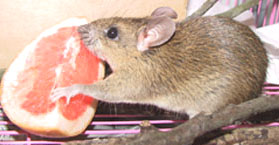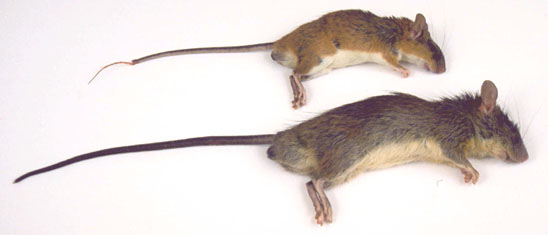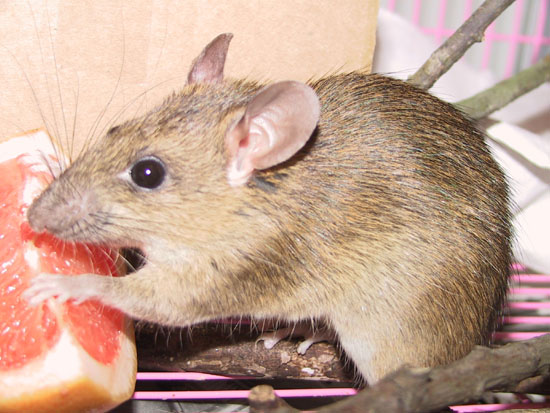

 |
 |
Vertebrates
The naming of Rats
by Richard Corlett
 |
Whoever said "Fools rush in where angels fear to tread" was surely thinking of rat taxonomy. I am therefore approaching this topic with some trepidation, but also, I hope, more as an unusually brave angel than a complete fool.
There are two common hillside rats in Hong Kong: the cute and lovable Chestnut Spiny Rat (or Chestnut Rat, or Chestnut White-bellied Rat), Niviventer fulvescens, and the larger, "rattier" rat species that has been known in Hong Kong for several decades as Sladen's Rat. The alert reader will now be thinking: Who was Sladen? What has he done to deserve having half Hong Kong's mammalian biomass named after him? I am afraid I do not know the answer to the first question, but I am sure the answer to the second, is: nothing at all. Sladen's Rat is - or was - Mus sladeni Anderson, 1879, collected from around 1000 m altitude in western Yunnan. This scientific name has since followed the same downward spiral as countless other Asian rat names: transfer to Rattus as Rattus sladeni, then reduction to a subspecies as Rattus rattus sladeni, and finally, reduction to a junior synonym of the Roof Rat, Rattus rattus (Corbet and Hill, 1992; see also under Sladen's Rat in Lekagul and McNeely, 1977). Along the way, the name appears to have been misapplied to a variety of other taxa, including, the larger, rattier rat of Hong Kong. It has also been widely misused for the same (?) species in Vietnam and Thailand.
Thus Sladen's rat is/was a form of the common Roof Rat, and nobody now seems to think it deserves separate taxonomic recognition. More importantly, it is not - I repeat, NOT - the larger, rattier rat of Hong Kong hillsides. We have Roof Rats in urban areas in Hong Kong, but the hillside rat is clearly a different species. So, what is it? Corbet and Hill (1992), whose names we usually follow in Hong Kong, say it is Rattus remotus, while Guy Musser at the American Museum of Natural History calls it R. sikkimensis. These names seem to be complete synonyms, referring to the same species that occurs from Nepal to South China, and south to Thailand. Corbet and Hill say R. remotus has priority, but the Smithsonian Institution Mammal Species of the World website still uses R. sikkimensis, so I presume there is some point of nomenclatural disagreement. Confusingly, though, neither name (nor R. sladeni, for that matter) seems to be used in China, and it is not at all clear what our rat is called there.
R. sikkimensis has been used more widely in Hong Kong than R. remotus, so I suggest we stick with it until someone does a proper revision of the Rattus rats. But what about the common name? It isn't Sladen's Rat, so we cannot continue to use that name. The Smithsonian web site suggests Sikkim Rat, which I suppose is O.K. Corbet and Hill make no suggestion, but Remote Rat would be a reasonable translation. Lekagul and McNeely (1977) call R. remotus the Island Rat, but distinguish it from our rat, for which they use R. koratensis (which they then call Sladen's Rat – but I was not going to tell you that!). Perhaps we should come up with something totally new which can be used for communication within Hong Kong, without implying any particular position on the taxonomy of Rattus: Hong Kong Rat? Ratty Rat? Hillside Rat? Please email your suggestions to me (corlett@hkucc.hku.hk), and I will report the best ones in the next issue.
Bibliography
Corbet, G.B. and Hill, J.E. (1992). The Mammals of the Indomalayan Region: a Systematic Review. Oxford University Press, Oxford.
Lekagul, B. and McNeely, J.A. (1977). Mammals of Thailand. Association for the Conservation of Wildlife, Bangkok, Thailand.
 |
Fig. 1 Niviventer fulvescens (above) and Rattus sikkimensis (?)
 |
Fig.2 The rat in question (photo by Kylie Chung).
P.15-16
|
Porcupine! |
 Copyright © 2000 |